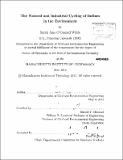The natural and industrial cycling of indium in the environment
Author(s)
White, Sarah Jane O'Connell
DownloadFull printable version (17.59Mb)
Other Contributors
Massachusetts Institute of Technology. Dept. of Civil and Environmental Engineering.
Advisor
Harold F. Hemond.
Terms of use
Metadata
Show full item recordAbstract
Indium is an important metal whose production is increasing dramatically due to new uses in the rapidly growing electronics, photovoltaic, and LED industries. Little is known, however, about the natural or industrial cycling of indium or its environmental behavior. Industrial emissions of indium are already larger than natural emissions. A review of the literature suggests that metal smelting and coal burning are the primary industrial sources of indium to the environment, while releases from the semiconductor and electronics industries are small at present. This scenario may change with the rapid growth of indium use in the electronics and semiconductor industries. Studies were conducted on indium cycling in the atmosphere, indium deposition to a peat bog over the past century, and indium behavior in a creek influenced by acid mine drainage. Atmospheric indium concentrations in the northeastern United State vary from <0.7 to 8 pg/m³. with significant differences geographically and temporally. Atmospheric back trajectories, correlation of indium to other metals in these samples, and receptor modeling suggest that the highest indium concentrations come from nonferrous smelters in the north, while lower concentrations are seen in air traveling from the midwestern US. Fluxes of indium to Thoreau's Bog in Concord, MA, began increasing in the early 1900s, well before indium was used significantly in industry, and are likely the result of emissions from nonferrous smelting and coal combustion. Fluxes peaked in the 1970s, and have been decreasing until the present, likely reflecting the advent of particulate emissions controls in the US and Canada. Acid-mine drainage contributes indium concentrations 104 times higher than natural freshwaters to Mineral Creek, Colorado, and all of this indium exists in the dissolved phase. During an experimental raising of the pH of this system, essentially all of the indium associates with the particulate phases, primarily due to sorption to iron-oxides. Knowledge of the anthropogenic and natural cycling of indium can lead to a greater understanding of the environmental impacts and human health effects of this metal. With further study, this understanding may lead to pollution prevention, and allow informed decision making about indium's use, handling, and disposal.
Description
Thesis (Ph. D.)--Massachusetts Institute of Technology, Dept. of Civil and Environmental Engineering, 2012. Cataloged from PDF version of thesis. Includes bibliographical references (p. 167-191).
Date issued
2012Department
Massachusetts Institute of Technology. Department of Civil and Environmental EngineeringPublisher
Massachusetts Institute of Technology
Keywords
Civil and Environmental Engineering.